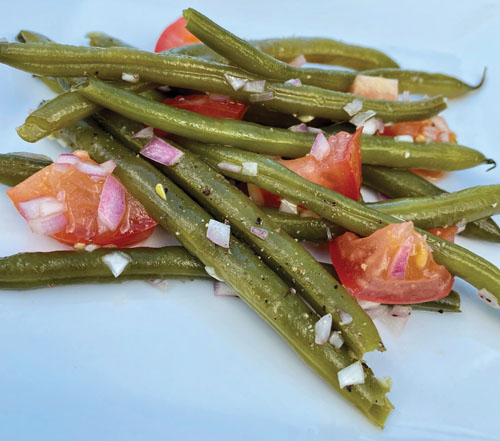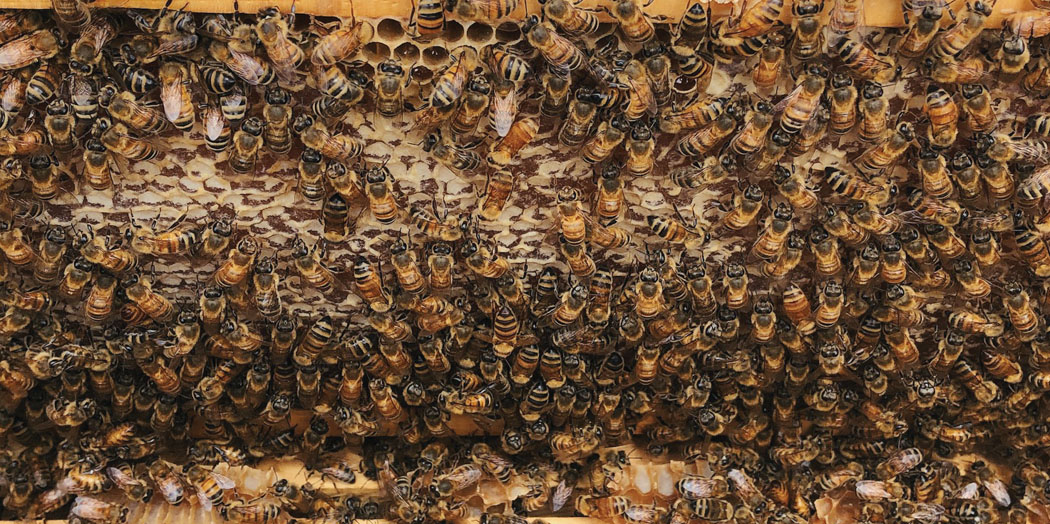
Oh, Honey! With Recipe for Green Bean Salad with Honey Vinaigrette

By Brittany P. Anderson
The first honeybees arrived on Hawai‘i Island in 1857. They made the journey from California by boat, after several unsuccessful attempts to bring them around South America from New England. Can you imagine sailing aboard a ship with several beehives buzzing below deck? It must have made for an exciting journey.
There are over 20,000 known types of bee, crossing every continent except for Antarctica, and their ancestors have existed for over 80 million years. All honeybees fall in the Apis genus, Latin for bee, which has at least 44 honey-producing sub-varieties. A group of hives is known as an apiary, and a person who tends bees can be referred to as an apiarist, or simply beekeeper.

Hawai‘i Islandʻs first honey bee residents were the German black bee, used to pollinate kiawe trees to increase seed production. Kiawe, Prosopis pallida, is a species of mesquite tree native to Ecuador, Columbia, and Peru that was brought to Hawai‘i Island sometime in the late 1820s. Kiawe beans were a staple fodder for the cattle ranches on the arid western shores of the island, so an increased production meant better cattle yields in the unforgiving terrain.
It wouldn’t be until 37 years later, in 1894, that the first commercial shipments of honey were exported from Hawai‘i. Shortly thereafter, large apiaries were established across the islands. Kiawe honey was one of the most prized kinds of honey of the time with its creamy texture and white coloration, and is still quite rare today. Lehua honey, made from the nectar of the ‘ōhi‘a lehua tree, gained favor on the mainland and abroad. It too has a thick crystalized texture and light coloration, and is only found in Hawai‘i.
The American Sugar Company on Moloka‘i added honey to its list of imports and in 1930 produced nearly 500,000 pounds of honey, earning its spot as the largest producer in the world that year. The industry suffered setbacks as American foulbrood, a deadly bacterial disease that kills off bee brood, wiped out many of the island’s apiaries. The price of honey also drastically dropped making it a less attractive investment for the big companies that controlled most Hawai‘i honey production.
Today, a group of dedicated beekeepers on Hawai‘i Island continue producing some of the world’s rarest honey, in addition to regional and varietal specific flavors. Honey flavors are indicative of the flowers they pollinate so every beekeeper has a special taste unique to their hives.
This recipe for Green Bean Salad with Honey Vinaigrette is a great summer side that would do well as part of a Niçoise salad. You might not want to use the coveted kiawe or lehua honey for this recipe. Instead, use a sweet varietal like wilelaiki (Christmas berry), or your nearest local honey for an apiary-to-table experience.
Green Bean Salad with Honey Vinaigrette
 1/2 pound green beans
1/2 pound green beans
2–3 small tomatoes, cut in eighths (optional)
Vinaigrette
1/2 tsp salt
1/2 cup minced red onion
1/4 cup apple cider vinegar
4 tsp local honey
1/2 tsp coconut oil
freshly ground pepper to taste
Method
Blanche a half pound of fresh green beans and drain in a colander. Place salt, onion, vinegar, honey, oil, and pepper in a bowl and stir. Put green beans and tomatoes in a dish with sides, so they are in an even layer. Drizzle the vinaigrette over the beans and tomatoes, toss lightly to coat. Then cover and marinate on the counter for at least 1 hour or refrigerate overnight. Enjoy!


